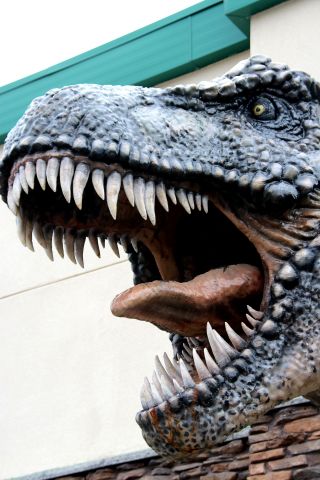
Toronto researcher’s theory would make T. Rex the “Mick Jagger” of dinosaurs
Everyone in Drumheller knows that the Tyrannosaurus rex, the king of dinosaurs, is usually shown baring sharp, gnarled teeth, but a Toronto researcher says the carnivore likely had lips that covered up its teeth.
Robert Reisz, a professor from the University of Toronto who specializes in vertebrate palaeontology, presented research at a conference of the Canadian Society of Vertebrate Palaeontology that says the T. rex’s and other theropods would not have teeth that stick out with closed mouths.
His research suggests that the study of living land animals with exposed teeth, such as elephants and boars, shows that the teeth of those animals contain no enamel, but are made of dentyne. The specimen record shows that the teeth of theropods has both enamel and dentyne, and makes it more likely that the dinosaurs had lips to cover their teeth.
Meanwhile, crocodiles are the only animal with exposed teeth that have enamel, but they are aquatic.
“It would change everything from museum displays to books,” says Francois Therrien, Curator of Dinosaur Palaeoecology at the Royal Tyrrell, who says he’s on the fence until the actual publication is released later.
“It’s not new. There has been debate for years over the facial reconstruction of dinosaurs because that’s what people are interested in – seeing passed the bones and seeing dinosaurs in the flesh as living animals.”
Therrien says if it was true, that therapods and other meat eaters did have lips, then dinosaurs would look more like a komodo dragon than a crocodile.
“Dinosaurs are strange because they are halfway between crocodiles and birds. So often times you have to look at these two extremes; crocodiles that really look like reptiles, and birds that really look like something from another world in comparison to reptiles, with dinosaurs somewhere in between, in order to reconstruct the fleshy appearance of dinosaurs.”
He says that it wasn’t until 1996 that palaeontologists knew meat-eating dinosaurs had feathers, rather than their typical depiction as green, scaley reptiles.
The confirmation of new hypotheses leads to a “trickle down” of knowledge starting with museum exhibits, then books, then popular culture, Therrien says.
“It will definitely change our perspective of these animals. Not only in their appearance but also something about their biology, too.”
“The perception of dinosaurs having toothy grins would change to something more mamallian looking in the sense that they cover their teeth with big lips.”
He says imagine the great overbite of a T. rex, with teeth ranging up to 15 cm in length, covered in massive lips.
“The T. rex would have been the Mick Jagger of dinosaurs,” laughs Therrien.
The research takes on a different significance in Drumheller, where representations of dinosaurs are the basis for the town’s draw as a tourist attraction.
If research revealed that such a massive revision of our imaginings of dinosaurs, it would call for a reconstruction of all the statues which populate Drumheller, including the World’s Largest Dinosaur.
“That’s how science works, it’s always open for revision and debate. Scientists will come and see that the models used by earlier scientists are actually an exception rather than a rule, and come up with a new hypothesis for reconstruction,” he said.
As far as modifying Drumheller’s towering mascot, Therrien said he’d leave it to someone else to make the suggestion to the mayor.



























